

Ñàíêò-Ïåòåðáóðãñêîå Îáùåñòâî Ëþáèòåëåé Îðõèäåé
Part 1
SUBFAMILIES APOSTASIOIDEAE, CYPRIPEDIOIDEAE AND SPIRANTHOIDEAE
The article opens serial publication of illustrated critical taxonomical survey of orchids in the flora of Vietnam . The first part of this monograph includes introduction, illustrated glossary of terminology used in identification keys and in description of taxa, key for identification of genera, as well as taxonomical treatment of three subfamilies Apostasioideae, Cypripedioideae and Spiranthoideae with 21 genera and 85 species. Valid name, necessary synonyms, type material citation, short description, data on ecology and distribution, as well as list of studied voucher specimens for each species are provided. Mentioned species and varieties are illustrated with line drawings and color photographs.
Contents
PREFACE
Basic primary knowledge on orchid taxonomy and diversity in Eastern Indochina and in Vietnam was obtained from landmark surveys (Gagnepain, Guillaumin, 1943; Pham-hoang, 1960, 1972, 1993, 2000; Averyanov, 1990, 1994; Seidenfaden, 1992) based mainly on collections of French and post-war periods housed now in largest part in Herbaria of Paris (P) and Saint Petersburg (LE). Mentioned publications were used in some compilative reviews few later (Tran Hop, 1998; Nguyen Thien Tich, 2001; Nguyen Tien Ban, Averyanov, Duong Duc Huen, 2005). According to most recent assessment (Averyanov, Averyanova, 2003) flora of Vietnam includes about 158 genera and 900 discovered orchid species, which may be estimated as about 80% of all orchids occurring on the territory of the country. Meanwhile, recent exploration of numerous earlier inaccessible territories of the country brings last time many more new discoveries, which essentially expand our knowledge about regional plant diversity. Illustrated taxonomical survey of all species hitherto reported for Vietnam including most recent discoveries based on collected voucher herbarium specimens is main goal of presented monograph.
Monograph treatment will successively follow family system of R.Dressler (Dressler, 1993) with few original additions and amendments. The orchid family system in used form is presented below as follow:
ORCHIDACEAE Juss.
Subfam. 1. Apostasioideae Reichenb.
Apostasia Blume, Neuwiedia Blume
Subfam. 2. Cypripedioideae Lindl.
Paphiopedilum Pfitz.
Subfam. 3. Spiranthoideae Dressler
Trib. 3.1. Tropidieae Dressler
Corymborkis Thouars, Tropidia Lindl.
Trib. 3.2. Cranichideae Endlicher
Subtrib. 3.2.1. Goodyerinae Klotzsch
Anoectochilus Blume, Cheirostylis Blume, Erythrodes Blume, Goodyera R.Br., Herpysma Lindl., Hetaeria Blume, Ludisia A.Rich., Macodes Lindl., Myrmechis Blume, Odontochilus Blume, Orchipedum Breda, Rhomboda Lindl., Vrydagzynea Blume, Zeuxine Lindl., Zeuxinella Aver.
Subtrib. 3.2.2. Spiranthinae Lindl.
Spiranthes L.C.Rich
Subfam. 4. Orchidoideae
Trib. 4.1. Diurideae Endlicher
Subtrib. 4.1.1. Acianthinae Schlechter
Corybas Salisb.
Subtrib. 4.1.2. Cryptostylidinae Schlechter
Cryptostylis R.Br.
Trib. 4.2. Orchideae
Subtrib. 4.2.1. Orchidinae
Amitostigma Schlechter, Brachycorythis Lindl., Hemipilia Lindl., Platanthera L.C.Rich., Vietorchis Aver. et Averyanova
Subtrib. 4.2.2. Habenariinae Bentham
Diplomeris D.Don, Habenaria Willd., Herminium R.Br., Pecteilis Rafin., Peristylus Blume
Subfam. 5. Epidendroideae Lindl.
Group of primitive tribes
Trib. 5.1. Neottieae Lindl.
Aphyllorchis Blume, Epipactis Sw., Listera R.Br.
Trib. 5.2. Vanilleae Blume
Subtrib. 5.2.1. Galeolinae Garay
Cyrtosia Blume, Erythrorchis Blume, Galeola Lour.
Subtrib. 5.2.2. Vanillinae Lindl.
Vanilla Sw.
Subtrib. 5.2.3. Lecanorchidinae Dressler
Lecanorchis Blume
Trib. 5.3. Gastrodieae Lindl.
Subtrib. 5.3.1. Gastrodiinae Lindl.
Didymoplexiella Garay, Didymoplexiopsis Seidenf., Didymoplexis Griff., Gastrodia R.Br., Yoania Maximowich
Subtrib. 5.3.2. Epipogiinae Schlechter
Epipogium R.Br., , Stereosandra Blume
Trib. 5.4. Nervilieae Dressler
Nervilia Gaudich.
Epidendroid group
Trib. 5.5. Arethuseae Lindl.
Subtrib. 5.5.1. Arundinae Dressler
Arundina Blume
Subtrib. 5.5.2. Bletiinae Bentham
Acanthephippium Blume, Anthogonium Lindl., Bletia Ruiz et Pavon, Calanthe R.Br., Cephalantheropsis Guillaum., Eriodes Seidenf., Hancockia Rolfe, Mischobulbon Schlechter, Nephelaphyllum Blume, Pachystoma Blume, Phaius Lour., Plocoglottis Blume, Spathoglottis Blume, Tainia Blume
Trib. 5.6. Malaxideae Lindl.
Subtrib. 5.6.1. Malaxidinae Benth. et Hook.f.
Liparis L.C.Rich., Malaxis Sw.
Subtrib. 5.6.2. Oberoniinae Aver.
Hippeophyllum Schlechter, Oberonia Lindl.
Trib. 5.7. Coelogyneae Pfitzer
Subtrib. 5.7.1. Thuniinae Schlechter
Thunia Reichenb.
Subtrib. 5.7.2. Coelogyninae Bentham
Coelogyne Lindl., Neogyna Reichenb.f., Otochilus Lindl., Panisea Steud., Pholidota Hook., Pleione D.Don
Trib. 5.8. Epidendreae Humb., Bonpl. et Kunth
Subtrib. 5.8.1. Glomerinae Schlechter
Agrostophyllum Blume
Subtrib. 5.8.2. Polystachyinae Pfitzer
Polystachya Hook.
Dendrobioid group
Trib. 5.9. Podochileae Pfitzer
Subtrib. 5.9.1. Eriinae Bentham
Callostylis Blume, Ceratostylis Blume, Cryptochilus Wall., Eria Lindl., Porpax Lindl., Trichotosia Blume
Subtrib. 5.9.2. Podochilinae Bentham et Hook.
Appendicula Blume, Podochilus Blume
Subtrib. 5.9.3. Thelasiinae Schlechter
Phreatia Lindl., Thelasis Blume
Subtrib. 5.9.4. Dendrobiinae Lindl.
Dendrobium Sw., Epigeneium Gagnep., Flickingeria Hawkes
Subtrib. 5.9.5. Bulbophyllinae Schlechter
Bulbophyllum Thouars, Hamularia Aver., Monomeria Lindl., Sunipia Smith, Trias Lindl.
Cymbidioid group
Trib. 5.10. Cymbidieae Pfitzer
Subtrib. 5.10.1. Bromheadiinae Dressler
Bromheadia Lindl.
Subtrib. 5.10.2. Eulophiinae Bentham
Eulophia R.Br., Dipodium R.Br., Geodorum Jackson
Subtrib. 5.10.3. Collabiinae Schlechter
Chrysoglossum Blume, Collabium Blume, Diglyphosa Blume
Subtrib. 5.10.4. Thecostelinae Schlechter
Thecopus Seidenf., Thecostele Reichenb.
Subtrib. 5.10.5. Cymbidiinae Benth.
Cremastra Lindl., Cymbidium Sw.
Subtrib. 5.10.6. Acriopsidinae Dressler
Acriopsis Blume
Subfam. 6. Vandoideae
Trib. 6.1. Vandeae Lindl.
Subtrib. 6.1.1. Aeridinae Pfitzer
Acampe Lindl., Adenoncos Blume, Aerides Lour., Arachnis Blume, Ascocentrum Schlechter, Ascocentropsis , Biermannia King et Pantl., Brachypeza Garay, Chiloschista Lindl., Christensonia Haager, Cleisocentron Bruehl, Cleisomeria G.Don, Cleisostoma Blume, Cleisostomopsis Seidenf., Cryptopylos Garay, Diploprora Hook.f., Doritis Lindl., Eparmatostigma Garay, Esmeralda Reichenb., Gastrochilus D.Don, Grossourdya Reichenb., Holcoglossum Schlechter, Hygrochilus Pfitzer, Kingidium P.F.Hunt, Luisia Gaudich., Malleola J.J.Smith, Micropera Lindl., Microsaccus Blume, Ornithochilus Lindl., Papilionanthe Schlechter, Parapteroceras Aver., Pelatantheria Ridl., Pennilabium J.J.Smith, Phalaenopsis Blume, Pomatocalpa Breda, Pteroceras Hassk., Renanthera Lour., Rhynchostylis Blume, Rhynchogyna Seidenf. et Garay, Robiquetia Gaudich., Saccolabiopsis J.J.Smith, Sarcoglyphis Garay, Schoenorchis Blume, Smitinandia Holttum, Stereochilus Lindl., Staurochilus Pfitzer, Taeniophyllum Blume, Thrixspermum Lour., Trichoglottis Blume, Tuberolabium Yamamoto, Uncifera Lindl., Vanda Jones, Vandopsis Pfitzer
Illustrated survey of three subfamilies - Apostasioideae, Cypripedioideae and Spiranthoideae is presented here in form of standard taxonomic treatment, which includes identification keys for all mentioned taxa and their short characterization. Correct name (with standard taxonomic reference), type, data about volume and distribution is reported for each taxonomic group. Data for each genus also include short description, total number of species and number of species in the flora of Vietnam (figures in brackets), as well as genus distribution.
For each species (subspecies or variety) is reported:
Text of labels is extremely abbreviated whenever being cited. It usually includes only province name, district name, collectors name and collector number, or, if necessary date of collection. Largest recent collections are abbreviated and designated as series with following prefixes:
CBL Cao Bang Limestone - collections on program of U.S.A. National Geographic Society " Limestone Flora of Cao Bang Province of northern Vietnam " (years 1998-1999, # 6300-98) with principal investigator Dr. Nguyen Tien Hiep,
CPNP collections in Cuc Phuong national park (commonly without indication of collectors),
DDS Prof. D.D.Soejarto - collections according to International Cooperative Biodiversity Groups program with this person as principal investigator,
DKH Dr. D.Harder - collections according to expeditions with this person as a principal investigator,
HAL Dr. Nguyen Tien Hiep, Prof. Leonid V. Averyanov, Prof. Phan Ke Loc - collections in collaborative explorations of these persons,
HLF Henry Luce Foundation, collections of different collectors according to Vietnam Botanical Conservation Program supported from Henry Luce Foundation,
LX-VN collections of Soviet-Vietnamese Expedition (commonly without exact indication of collectors),
NMC collections of staff member of Cuc Phuong national park Mr. Nguyen Manh Cuong on the territory of the national park,
NTH Dr. Nguyen Tien Hiep - collections in expeditions with this person as principal investigator,
P Prof. Phan Ke Loc - collections in expeditions with this person as principal investigator,
VA - Vietnam-American Series collections of international group with Dr. N.T.Hiep as principal investigator.
VH Vietnamese Highlands - collections on program of U.S.A. National Geographic Society Flora of Highlands of South Vietnam (years 1993-2001, # 5094-93, 5803-96, 6383-98) with principal investigator Prof. Leonid V. Averyanov.
WP Vietnam-Chinese expedition of 2003 year with Prof. Phan Ke Loc as co-leader from Vietnamese Side.
Modern administrative divisions of Vietnam into provinces and city territories, as well as list of their names, which are used in indication of species distribution within Vietnam , are presented on map 1.
Illustrated glossary of orchid terminology used in identification and plant descriptions is presented below in the next chapter.
Map 1. Modern administrative division of Vietnam territory (for 2007 year) (except Hoang Sa |
|||
Names of provinces, names of city areas and figures designating these units on the map:
|
ILLUSTRATED GLOSSARY
OF THE ORCHID IDENTIFICATION TERMINOLOGY
Additional explanations of terms are available on cited figures (Fig. 1-12).
Abaxial the side away from the axis, normally the lower surface.
Acaulescent becoming stemless.
Acaulous stemless or nearly so.
Achlorophyllous without chlorophyll, as in plants or plant structures lacking green color.
Actinomorphic radially symmetrical.
Aculeate prickly; covered with prickles.
Acuminate having a gradually tapering point. Fig. 12.
Acute distinctly and sharply pointed, but not drawn out. Fig. 12.
Adaxial the side toward the axis, normally the upper surface.
Adnate united or joined together.
Adpressed (appressed) lying flat for the whole length of the organ.
Amplexicaul clasping the stem.
Androclinium see clinandrium.
Androecium all of the stamens in a flower.
Anther the expanded, apical, pollen bearing portion of the stamen. Fig. 4-7, 10.
Anther cup (operculum) highly modified, easily removable lid-like anther wall, which covers pollinia placed on the top of column in many representatives of Dendrobioideae and Vandoideae subfamilies. Fig. 8-10.
Antrorse directed forward or upward.
Aphyllous without leaves.
Apiculate with a short, sharp, but not stiff, point. Fig. 12.
Appressed see adpressed.
Approximate drawn close together, but not united.
Aristate awned, sharply terminated by a hard, straight point. Fig. 12.
Articulate jointed. Fig. 3.
Articulation point of attachment. Fig. 3.
Attenuate tapering gradually to a narrow base. Fig. 12.
Auricle 1 a small lateral outgrowth on the top of column in representatives of subfamily Orchidoideae. Fig. 7.
Auricle 2 a small, ear-shaped appendage, commonly at the base of lip or leaf. Fig. 12.
Auriculate with a small ear-like lobe. Fig. 12.
Axial placentation placentation when ovules attached to the central axis of an ovary with two or more locules. Fig. 2, a .
Axil the point at the angle between a leaf and a stem.
Axillary borne in the axil.
Bark epiphytes (trunk epiphytes) epiphytes growing on branches of middle size in medium zone of tree canopies. Fig. 1, f .
Trunk epiphytes see bark epiphytes.
Berry a fleshy, many-seeded fruit composed of more than one carpel.
Bicuspidate having 2 sharp points.
Bidentate with two teeth. Fig. 12.
Bifid divided into 2 shallow segments, usually at the apex. Fig. 12.
Bifurcate forked.
Bipartite divided nearly to the base into two portions.
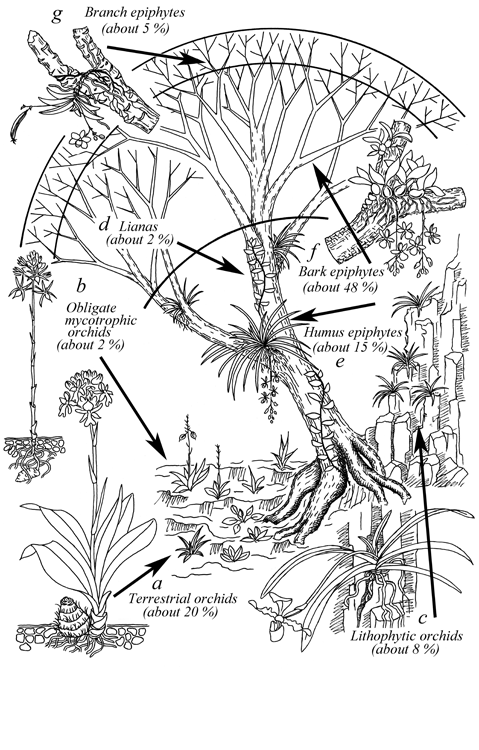
Fig. 1. Ecological groups of orchids and their habitats.
Orchids in the flora of Vietnam may be terrestrial plants (a, about 20%), achlorophyllous
obligate mycotrophic (saprophytic) herbs (b, about 2%), lithophytes (c, about 8%), lianas or
vines (d, about 2%), humus epiphytes (e, about 15%), bark epiphytes (f, about 48%) and
branch epiphytes (g, about 5%).
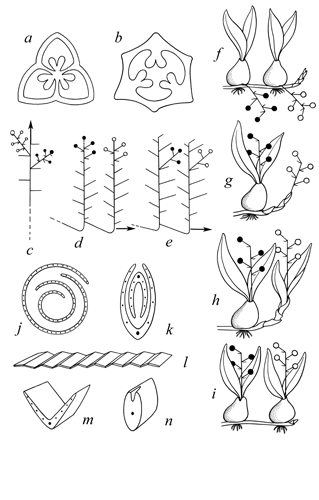
Fig. 2. Basic orchid morphology: a, b transversal section of ovary with axial placentation in
Apostasia odorata (a) and parietal placentation in Dendrobium cariniferum (b); c-e main
types of orchid growth system with monopodial shoot (c), sympodial shoot with apical inflorescence
(d) and sympodial shoot with lateral inflorescence (e); rings designate flowers, filled
rings designate fruits, lines designate bracts/leaves, arrows show direction of growth, broken
line designate obsolete old part of shoot; f-i main types of orchid inflorescences according
to features of their development: heteranthous in Coelogyne cristata (f), proteranthous in
C. lentiginosa (g), synanthous in Pholidota rubra (h) and hysteranthous (i) inflorescence in
C. fimbriata; j, k types of leaf development (transversal section of developing leaves) with
convolute leaves in Liparis nervosa (j) and duplicate leaves in C. fimbriata (k); l-n types of
orchid leaves (transversal section of mature leaves) with plicate in Tainia viridifusca (l),
conduplicate in Paphiopedilum concolor (m) and laterally flattened leaves in Oberonia
ensiformis (n).
Bract more or less reduced leaf-like organ bearing a flower, inflorescence or partial inflorescence in its axil. Fig. 3.
Branch epiphytes (canopy epiphytes) epiphytes growing on small branchlets and perennial leaves in peripheral zone of tree canopies. Fig. 1, g .
Canopy epiphytes branch epiphytes.
Broadly elliptic - spindle-shaped, two-dimensional; with an index from 1 to about 1.4. Fig. 11.
Broadly lanceolate lance-shaped, narrow, tapering toward the apex more than toward the base; with an index from 3 to around 4. Fig. 11.
Broadly oblanceolate inversely broadly lanceolate. Fig. 11.
Broadly obovate inversely broadly ovate. Fig. 11.
Broadly ovate egg-shaped in outline, broader at the base, two-dimensional; with an index less than 1.4. Fig. 11.
Broadly triangular three-angled, with an index less than 0.85. Fig. 11.
Bursicle a cup-like covering over the viscidium in some representatives of subtribe Orchidinae. Fig. 10.
Caducous falling off early, like floral bracts in some species of Calanthe or Coelogyne .
Caespitose tufted.
Callus (pl. calli) a thickening or protuberance, commonly on the lip. Fig. 6.
Calyculus a small cup or circle of bract-like structures outside of the sepals in species of Lecanorchis . Fig. 8.
Campanulate bell-shaped.
Canaliculate channeled, with a longitudinal groove.
Canopy epiphytes see branch epiphytes. Fig. 1, g .
Capilletium the sterile kapok-like hairs within the fruit mellowing seed masses, particularly in epiphytes. Fig. 9.
Capitate head-like.
Capsule a dry, many-seeded, dehiscent fruit composed of more than one carpel. Fig. 9.
Carinate keeled.
Carpel highly modified megasporophyll, formed from one modified leaf bearing ovules (megasporangia) and seeds; in the orchids, the three carpels are so united and modified as to be nearly unrecognizable. Fig. 2, a , b.
Caudate tailed; with a tail-like appendage. Fig. 12.
Caudicle a slender elastic extension of the pollinium, or a mealy portion at one end of the pollinium; the structure is a part of the pollen, which is formed within the anther. Fig. 6, 7, 10.
Central relating to the central part of a body.
Ciliate having fine hairs at the margin, refers usually to the margin of leaf or tepal. Fig. 12.
Clavate club-shaped, pointed at one end and rounded at the other.
Claw the conspicuously narrowed and attenuate base of an organ.
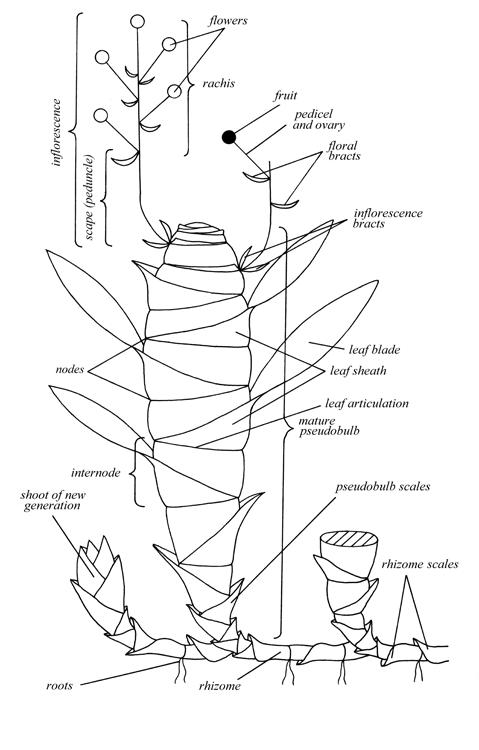
Fig. 3. Structure of orchid shoot.
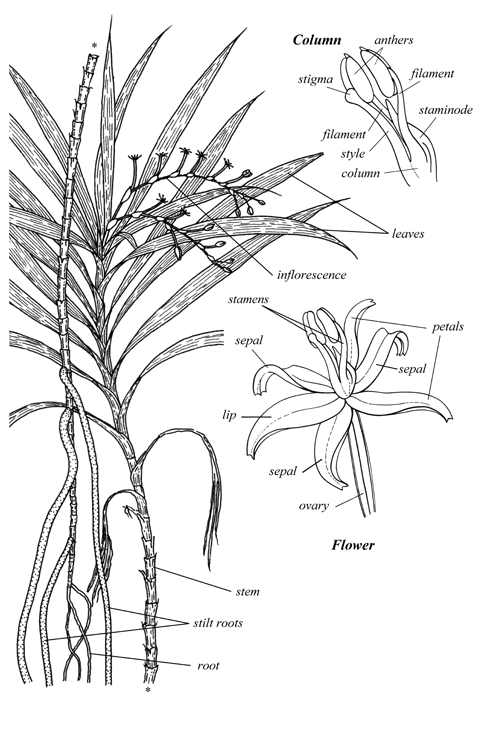
Fig. 4. Orchid morphology (subfamily Apostasioideae).
Cleistogamous refers to flowers which regularly self-pollinate without opening.
Clinandrium (androclinium) the anther bed, that part of the column under, or surrounding, the anther. Fig. 9.
Column more or less modified structure formed by union of filaments and style. Fig. 4-6, 8-10.
Column wing a wing- or arm-like appendage of the column, usually lateral.
Columnfoot a ventral extension of the base of the column which has the lip attached at its tip. Fig. 8.
Complanate flattened or compressed.
Conduplicate leaf or leaf-like organs, with a single median fold, with each half being flat. Fig. 2 , m .
Congeneric belong to the same genus.
Connate united.
Connective the sterile portion of the filament connecting the two pollen sacs of an anther. Fig. 7, 10.
Connivent coming into close contact or converging, but not united.
Conspecific belonging to the same species.
Convolute rolled up longitudinally with parts in an overlapping arrangement. Fig. 2, j.
Cordate heart-shaped with the base at the broad, notched end. Fig. 11, 12.
Coriaceous leathery.
Corolla the inner whorl of the perianth, petals.
Corymb flat-topped inflorescence.
Crenate scalloped, toothed with crenations. Fig. 11.
Crenulate crenate, but the teeth small. Fig. 11.
Cristate crested.
Cucullate hooded, hood-shaped.
Cuneate wedge-shaped. Fig. 12.
Cuspidate tipped with a sharp, rigid point. Fig. 12.
Decurved curved or bent down.
Deflexed bent outwards.
Dentate toothed. Fig. 11.
Denticulate minutely toothed. Fig. 11.
Determinate a habit of growth in which each unit has a limited growth, usually in sympodial shoot.
Disc the face of any flat organ with special reference to the lip.
Distal away from the base, toward the apex.
Distichous having leaves or other organs in two opposite rows.
Dorsal refers to the back or outward surface of an organ in relation to the axis; in orchids refers to the upper side of the flower; see abaxial.
Dorsal sepal see median sepal.
Dorsiventral an organ which has more or less distinct dorsal and ventral surfaces, as a non-terete leaf.
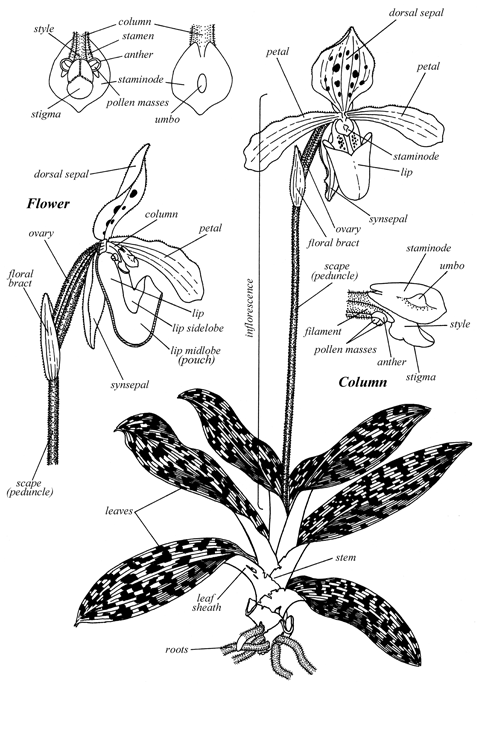
Fig. 5. Orchid morphology (subfamily Cypripedioideae).
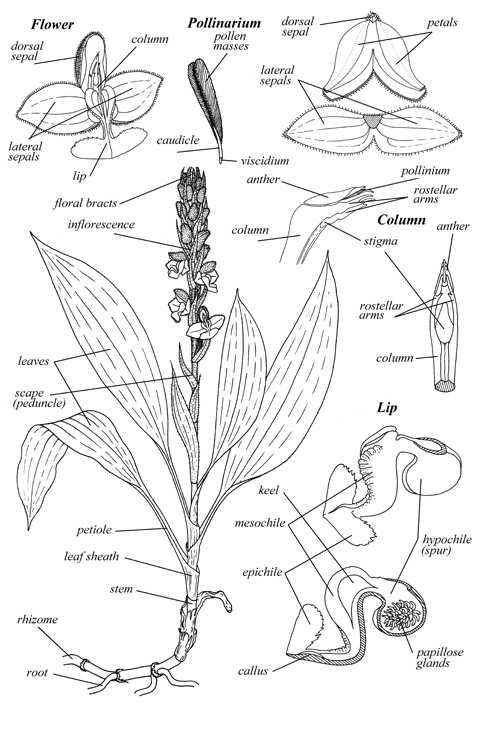
Fig. 6. Orchid morphology (subfamily Spiranthoideae).
Duplicate refers to the folding of leaves during development, folded once with each half flat. Fig. 2, k.
Echinate with numerous stiff hairs or spines.
Elastoviscin a very elastic substance found in pollinia and especially in caudicles.
Ellipsoid - spindle-shaped; narrow and tapering at the ends, three-dimensional.
Elliptic - spindle-shaped, two-dimensional; with an index around 1.4-3. Fig. 11.
Emarginate notched, usually at the apex. Fig. 12.
Endemic confined to a given region.
Ensiform sword-shaped. Fig. 11.
Entire simple and with a smooth edge, as contrasted to toothed or lobed. Fig. 11.
Ephemer living a very short time (usually annual plants of arid areas).
Ephemeral of flowers, referring to those which last only a few hours.
Ephemeroid perennial plants of arid areas with very short vegetative and reproductive periods.
Epichile - the terminal part of a complex lip when it is distant from the basal portion. Fig. 6.
Epigeous growing upon the ground.
Epiphyte a plant growing on another plant but not parasitic. Fig. 1, e-g.
Equitant said of conduplicate or laterally flattened leaves or bracts which overlap each other in two ranks.
Erose bitten or gnawed. Fig. 11.
Extrafloral occurring outside of a flower; refers usually to glands that are found outside of flower buds.
Falcate sickle-shaped. Fig. 11.
Farinose mealy.
Fasciculate clustered or bundled.
Filament the stalk of the stamen which bears the anther. Fig. 4, 5.
Filiform thread-like.
Fimbriate fringed, refers usually to the margin of leaf or tepal. Fig. 11.
Flabellate fan-shaped. Fig. 11.
Flexuose bent alternately in opposite directions.
Flora the array of all plant species occurring in a region.
Floral bract more or less reduced leaf-like organ bearing a flower (or reduced floral bud) in its axil. Fig. 3, 5, 6, 8.
Fovea a small depression or pit, like in lip of Malaxis species.
Fusiform spindle-shaped.
Geniculate abruptly bent like a knee-joint.
Geophyte plants, in which new annual shoot develops from underground bud, usually tuberiferous or bulb ephemeroids.
Gibbous swollen or enlarged on one side; ventricose.
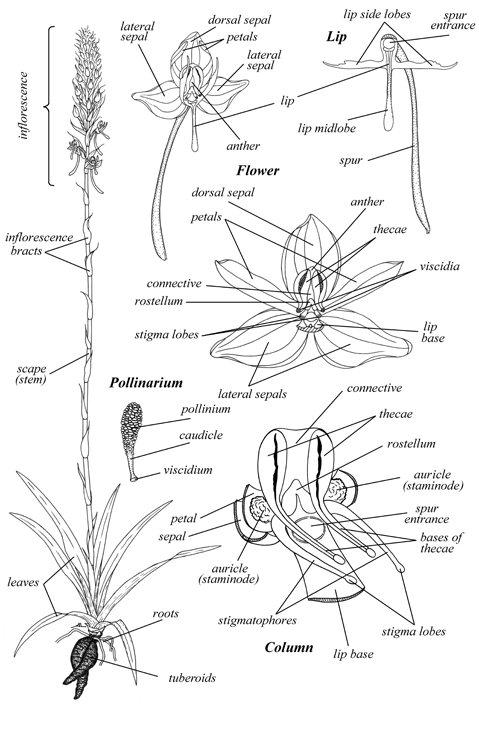
Fig. 7. Orchid morphology (subfamily Orchidoideae).
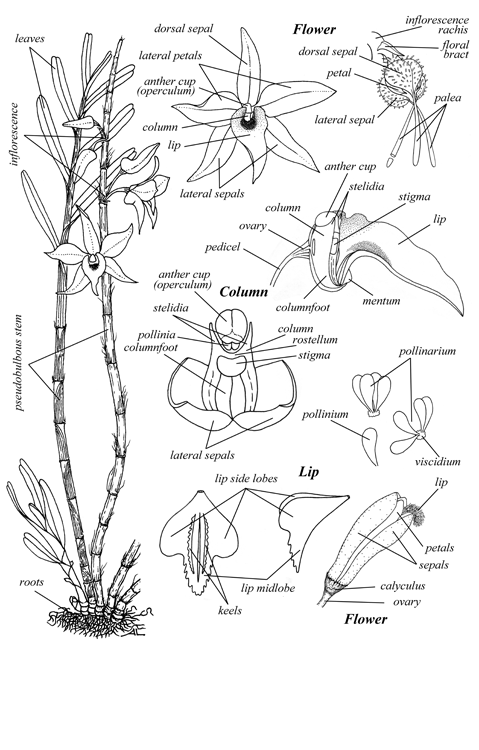
Fig. 8. Orchid morphology (subfamily Epidendroideae).
Glabrous hairless.
Gland 1 an appendage, protuberance, or other structure which secretes nectary substances. Fig. 6.
Gland 2 see viscidium.
Globose spherical.
Gynostemium see column.
Hamulus a pollinium stalk which is formed by modified bended rostellum apex. Fig. 10.
Hastate spear-shaped, with the basal lobes turned outwards. Fig. 11, 12.
Heteranthous an apical inflorescence produced on a separate shoot which does not develop to produce a pseudobulb and leaves. Fig. 2, f .
Hirsute hairy.
Hispid bristly.
Humus epiphytes epiphytes growing in forks of tree stem on thick accumulations of humus. Fig. 1, e.
Hyaline glass-like, colorless, translucent.
Hygroscopic capable of absorbing moisture from the atmosphere.
Hypochile the basal portion of a complex lip. Fig. 6, 9.
Hysteranthous an apical inflorescence produced after the pseudobulbs and leaves have developed. Fig. 2, i.
Imbricate overlapping.
Incumbent lying on or against.
Indehiscent not opening at maturity along definite lines or by pores.
Index (leaf, tepal index) the length of flat figure divided by its width.
Indumentum any covering, commonly refers to hairiness.
Inferior inserted below, like the ovary in the orchids.
Inflorescence the flowering part of a plant, which includes usually floral axis, floral bracts and flowers. Fig. 3, 5-9.
Inflorescence bract more or less reduced leaf-like organ bearing an inflorescence or partial inflorescence (or reduced inflorescence bud) in its axil. Fig. 3, 7.
Internode the section of a stem between two nodes. Fig. 3.
Isthmus a narrow portion of a lip or petal.
Keel a prominent longitudinal ridge, like the keel of a boat. Fig. 6, 8, 9.
Labellum see lip.
Lacerate cut or cleft irregularly, refers usually to the margin of leaf or tepal. Fig. 11.
Lacinate cut into narrow, irregular lobes or segments, refers usually to the margin of leaf or tepal. Fig. 11.
Lamella a membrane or septum.
Lamina a blade, the expanded flat portion of a leaf or tepal.
Lanceolate lance-shaped, narrow, tapering toward the apex more than toward the base; with an index around 4-7. Fig. 11.
Lateral borne on or near the side of midline of a bilaterally symmetrical organ.
Lateral sepals - adaxial segments of the outer whorl of perianth (calyx). Fig. 6-9.
Laterally flattened compressed from lateral sides.
Lax loose, distant.
Leaf blade the broad part of a leaf. Fig. 3.
Leaf index see index.
Leaf sheath the leaf base which surrounds the stem. Fig. 3, 5, 6.
Liana a plant with long stem not self-supporting, but climbing or trailing on any erect substratum. Fig. 1, d.
Ligulate with a ligule; strap- or tongue-shaped.
Ligule a strap-like body.
Linear leaf blade at least 12 times longer than broad, with the sides parallel. Fig. 11.
Lingulate tongue-shaped.
Lip - in orchids highly modified median (adaxial) segment of the inner whorl of perianth (corolla). Fig. 4-9.
Lithophyte growing on stones and rocks. Fig. 1, c.
Lobule a small lobe.
Longitudinal section (sagittal section) section along axis of an organ.
Lunate half-moon shaped.
Massula (pl. massulae) a packet of pollen.
Median situated on the midline of a bilaterally symmetrical organ.
Median sepal abaxial segment of the outer whorl of perianth (calyx). Fig. 5-9.
Mentum a chin-like projection formed by the lateral sepals and extended columnfoot. Fig. 8.
Mesochile - the middle portion of a complex lip. Fig. 6.
Monopodial growth indefinite growth which continues from a terminal bud from season to season. Fig. 2, c.
Mucro a sharp terminal point. Fig. 12.
Mucronate tipped with a short, sharp, abrupt point (mucro). Fig. 12.
Mycorrhiza a symbiotic relationship between a fungus and the root of a plant.
Mycotrophic (saprophytic) plants which obtain nutrients from fungi by means of mycorrhizal symbiotic or parasitic relationships. Fig. 1, b.
Myrmecophyte any plant which is associated with ants.
Narrowly elliptic - spindle-shaped, two-dimensional; with an index around 3-8. Fig. 11.
Narrowly lanceolate lance-shaped, narrow, tapering toward the apex more than toward the base; with an index from 7 to around 12. Fig. 11.
Narrowly oblanceolate inversely narrowly lanceolate. Fig. 11.
Narrowly obovate inversely narrowly ovate. Fig. 11.
Narrowly ovate egg-shaped in outline, broader at the base, two-dimensional; with an index about 1.6-3. Fig. 11.
Nectary a nectar-producing structure or gland.
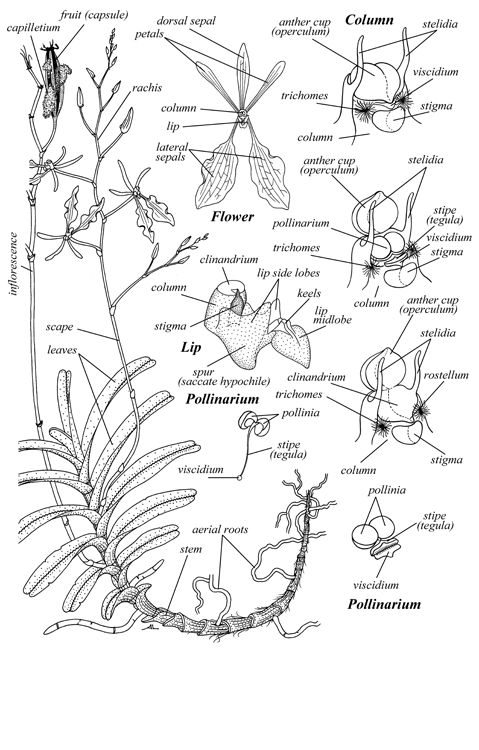
Fig. 9. Orchid morphology (subfamily Vandoideae).
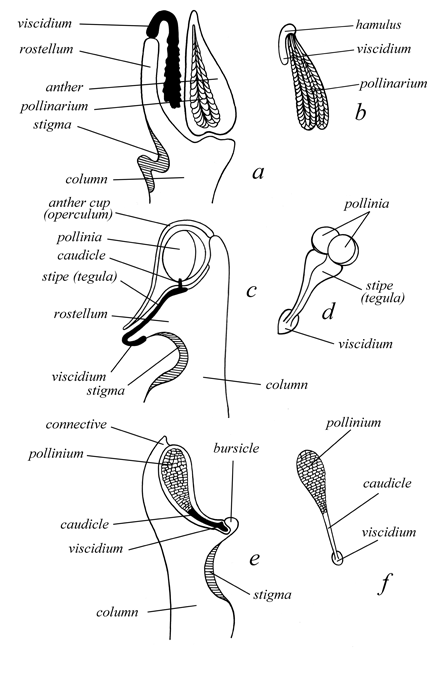
Fig. 10. Main types of pollinaria and pollinium stalk in orchids: a, b sagittal section of column
(a) and pollinarium (b) of flower of Tropidia curculigoides, that illustrate hamulus formation;
c, d sagittal section of column (c) and pollinarium (d) of flower of Doritis pulcherrima, that
illustrate stipe (tegula) formation; e, f sagittal section of column (e) and pollinarium (f) of
flower of Dactylorhiza incarnata, that illustrate caudicle formation.
Node the point on a stem at which a leaf or bract is attached. Fig. 3.
Non-resupinate flower - the flower with not-resupinate ovary having the lip turned upwards.
Obcordate inversely cordate. Fig. 11.
Oblanceolate inversely lanceolate. Fig. 11.
Obligate restricted to particular conditions or circumstances, like achlorophyllous mycotrophic plants. Fig. 1, b.
Oblique with unequal sides; slanting. Fig. 12.
Oblique bifid divided into 2 unequal shallow segments, usually at the apex. Fig. 12.
Oblong much longer than broad, with nearly parallel sides, rounded at each end. Fig. 11.
Obovate inversely ovate. Fig. 11.
Obsolete wanting or rudimentary.
Obtuse blunt or rounded at the apex. Fig. 12.
Ombrophilous adapted to shady habitats of humid rainy forest.
Operculum see anther cup. Fig. 8.
Orbicular of a flat body with a circular outline. Fig. 11.
Oval oval-shaped, not much longer than broad, with nearly parallel sides, rounded at each end. Fig. 11.
Ovary the part of the flower that contains ovules and develops into the fruit. Fig. 3-5, 8.
Ovate egg-shaped in outline, broader at the base, two-dimensional; with an index around 1.4-1.6. Fig. 11.
Ovoid egg-shaped, three-dimensional.
Palea flat or terete, moveable appendages attached by a filiform base, found on tepals in some species of Bulbophyllum . Fig. 8.
Pandurate violin- or fiddle-shaped. Fig. 11.
Panicle a much branched inflorescence.
Paniculate branched, branching (of an inflorescence).
Papilla (pl. papillae) a soft, short, superficial gland or protuberance. Fig. 6.
Papillose covered with papillae.
Parietal placentation placentation when ovules are attached to the walls of the ovary. Fig. 2, b .
Pectinate comb-like; with close, regularly spaced teeth or hairs, often in a single row, like the teeth of a comb.
Pedicel the stalk of a single flower in an inflorescence. Fig. 3, 8.
Peduncle the stalk bearing an inflorescence or solitary flower. Fig. 3, 5, 6.
Peloric a more or less radially symmetrical mutant of a species which normally has zygomorphic flowers.
Peltate shield-shaped.
Pendent hanging.
Pendulous hanging.
Perianth (tepals) a collective term for sepals and petals, together.
Petals in orchids two lateral segments of the inner whorl of perianth (corolla). Fig. 4, 5, 7, 9.
Petiolate leaf leaf with distinct petiole and leaf blade.
Petiole a leaf stalk. Fig. 6.
Pilose soft hairy.
Pistil the female reproductive organ of a flower, typically consisting of a stigma, style and ovary.
Placenta that portion of the ovary that bears the ovules.
Placentation the arrangement of ovules and configuration of the placentas in ovary. Fig. 2, a , b.
Plicate pleated or folded leaves having several to many major longitudinal veins and folded in each one. Fig. 2, l .
Pollen masses see Pollinium.
Pollinarium (pl. pollinaria) the complete set of pollinia with associated parts, like viscidium (viscidia) and stipe. Fig. 6-10.
Pollinium (pl. pollinia) a more or less compact mass of pollen. Fig. 6-10.
Porate pollinium pollinium with a pore or pores.
Porrect directed outward and forward.
Prostrate lying flat on the ground.
Proteranthous an apical inflorescence produced before the pseudobulbs and leaves on the same shoot. Fig. 2, g .
Proximal the part nearest the axis, toward the base.
Pseudobulb a swollen aerial stem. Fig. 3, 8.
Pseudocopulation a special type of pollination, in which flowers mimic female insects and are pollinated by the males when they attempt to copulate with the flowers.
Pseudopollen mealy, farinose, pollen-like deposit (originated from highly modified papillae) on the lip of some species of Eria and Dendrobium .
Pubescent softly hairy or downy.
Pulvinate cushion-like.
Pustulate - see pustulose.
Pustulose (pustulate) having small blisters or pustules.
Pyriform pear-shaped. Fig. 11.
Quaquaversal directed or bending in every direction.
Raceme an unbranched, elongate, indeterminate inflorescence with pedicellate flowers maturing from the base upwards.
Racemose having flowers in racemes.
Rachis the axis of an inflorescence. Fig. 3, 8, 9.
Recurved curved backwards or downwards.
Reflexed abruptly bent or turned downwards or backwards.
Reniform kidney-shaped. Fig. 11.
Resupinate flower the flower with resupinate ovary having the lip turned down.
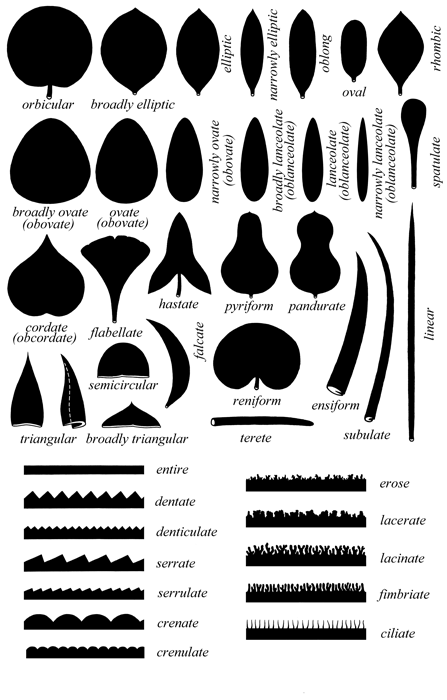
Fig. 11. Main types of shapes and margins of orchid leaf and tepal.
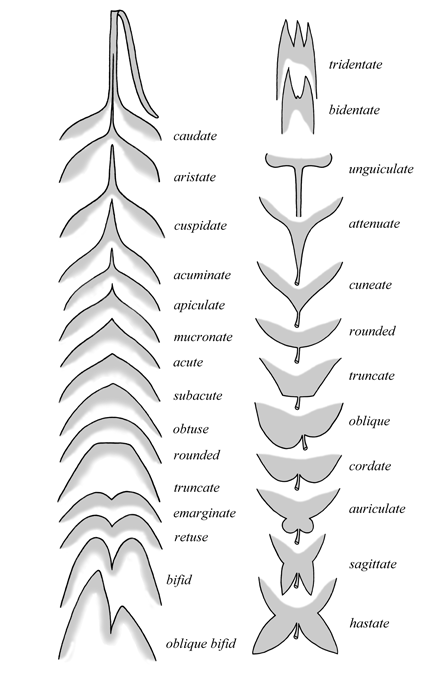
Fig. 12. Main types of apices and bases of orchid leaf and tepal.
Reticulate netted.
Retrorse directed backwards or downwards.
Retuse shallowly notched at a rounded apex. Fig. 12.
Revolute rolled back from the margin.
Rhizome horizontal, underground or surface-resting stem bearing scale leaves and adventitious roots; in sympodial orchids composed of the bases of successive shoots. Fig. 3, 6.
Rhombic diamond-shaped. Fig. 11.
Rhomboidal quadrangular, nearly rhombic, with obtuse lateral angles.
Root ridge elongate callus on fleshy rhizome which bears tufts of root hairs in some rootless orchids like species of Cheirostylis .
Root-stem tuberoid see tuberoid.
Rosette a densely clustered spiral of leaves, usually borne near the ground.
Rostellum highly modified, often beak-like sterile median portion of stigma lying between the functional part of stigma (stigmas) and stamen. Fig. 6-10.
Rostellar arms lateral narrow wing-like rostellar extensions in some representatives of subtribe Goodyerinae. Fig. 6.
Rostrate beaked.
Rosulate with the leaves arranged in basal rosettes on very short stem.
Rotund circular in outline.
Round see rounded.
Rounded (round, rotund) with a rounded apex or base. Fig. 12.
Rugose wrinkled.
Rugulose somewhat wrinkled
Saccate with a conspicuous swelling hollow.
Sagittal section see longitudinal section.
Sagittate arrowhead-shaped. Fig. 12.
Saprophyte plants which obtain nutrients by absorption of organic substances from the soil (as a rule, indirectly, by means of mycorrhizal symbiotic or mycotrophic relationships with soil fungi). Fig. 1, b.
Saprophytic see mycotrophic.
Scale any thin, flat, scarious structure commonly of leaf origin. Fig. 3.
Scandent climbing.
Scape a leafless and flowerless lower part of an inflorescence. Fig. 3, 5-7, 9.
Scarious thin, dry and membranous.
Scattered arranged without apparent order.
Sectile the conditions in which soft, granular pollinia are subdivided into small packets, which are usually connected by elastic threads.
Secund arranged on one side of the axis only.
Semicircular half-round. Fig. 11.
Sepals in orchids three segments of the outer whorl of perianth (calyx). Fig. 4.
Septum a partition, like in the spur or sac in many species of subtribe Aeridinae.
Serrate saw-like; toothed along the margin, with the sharp, regular teeth pointing forward. Fig. 11.
Serrulate saw-like; toothed along the margin with minute, sharp, regular forward-pointing teeth. Fig. 11.
Sessile attached directly, without stalk or petiole.
Sessile leaf leaf lacking the petiole.
Seta (pl. setae) a bristle.
Setaceous bristle-like; with bristles.
Sheath a leaf-like structure which enfolds a stem, pseudobulb, or young inflorescence.
Sigmoid S-shaped.
Spatulate oblong and attenuated at the base, like a spatula. Fig. 11.
Spicate arranged in a spike.
Spike an unbranched inflorescence with sessile or subsessile flowers maturing from the bottom upwards.
Spur a slender, tubular or sac-like often nectar-containing projection commonly formed by the base of the lip. Fig. 6, 7, 9.
Stamen the male reproductive organ of a flower, consisting of an anther and filament. Fig. 5.
Staminode (staminodium) a sterile stamen, often modified in shape and size. Fig. 4, 5, 7.
Staminodium see staminode.
Stelidium (pl. stelidia) a wing- or arm-like lateral appendage on the top of the column. Fig. 8, 9.
Stigma the portion of the pistil which is receptive to pollen. Fig. 4-6, 8-10.
Stigma lobes two completely separated lateral lobes of stigma. Fig. 7.
Stigmatophore an elongated process on either side of the base of the column bearing lateral stigmatic lobe. Fig. 7.
Stipe (tegula) a non viscid band or strap of columnar tissue which connects the pollinia to the viscidium. Fig. 9, 10.
Stipitate raised on a stalk.
Style the slender part of the pistil which connects the ovary with the stigma; forms a part of the column. Fig. 4, 5.
Subacute slightly acute. Fig. 12.
Subulate awl-shaped. Fig. 11.
Sulcate with longitudinal grooves or furrows.
Sympodial growth growth in which each new shoot is determinate and terminates in one season with terminal or lateral inflorescence. Fig. 2, d, e.
Synanthous an inflorescence when pseudobulb, leaf and apical inflorescence are produced together. Fig. 2, h .
Synsepal (synsepalum) a compound organ formed by the union of two lateral sepals, like in species of Paphiopedilum . Fig. 5.
Tegula see stipe.
Tepal index see index.
Tepals see perianth.
Terete cylindric and usually tapering. Fig. 11.
Terminal the end or apex.
Terrestrial ground dwelling plants, usually with creeping rhizome, ground pseudobulbs or subterranean tuber (root-stem tuberoids). Fig. 1, a .
Tessellate chequered.
Theca (pl. thecae) a pollen sac or cell of the anther. Fig. 7.
Tomentose densely covered with matted woolly or short hairs.
Triangular three-angled, with an index more than 0.85. Fig. 11.
Trichome a hair or hair-like outgrowth of the epidermis. Fig. 9.
Tridentate three-toothed. Fig. 12.
Truncate ending abruptly, as though broken off. Fig. 12.
Trunk epiphytes - see bark epiphytes. Fig. 1, f .
Tuber in orchids see tuberoid.
Tuberoid (root-stem tuberoid) a thickened, more or less modified tuber-like root with a bud and some anatomical stem structures at the base. Fig. 7.
Umbo a small blunt or rounded protuberance, as on the ventral surface of staminode in some species of Paphiopedilum . Fig. 5.
Umbonate having a central, projecting point, like the boss of a shield.
Uncinnate hook-shaped.
Undulate waved.
Unguiculate contracted at the base into a claw. Fig. 12.
Urceolate pitcher-, vase- or urn-shaped.
Velamen one or more layers of hygroscopic spongy dead cells on the outside of a root.
Ventral refers to the front or inward surface of an organ in relation to the axis; see adaxial.
Ventricose swollen or inflated on one side.
Verrucose warty.
Verticillate whorled.
Villose with long, weak hairs.
Vine see liana.
Viscidiophore an elongated prolongation of the base of theca (anther canal) and rostellum side lobes bearing at the apex viscidium. Fig. 7.
Viscidium (pl. viscidia) a viscid, usually disc-like part of the rostellum joined to the pollinium, enabling it to adhere to an insect-pollinator body. Fig. 6-10.
Whorl a circle of three or more leaves or leaf-like organs attached at the same level on a stem.
Zygomorphic bilaterally symmetrical.
ACKNOWLEDGEMENTS
Laboratory studies and work with manuscript and illustrations was supported by Swiss Orchid Conservation fund of Zurich Foundation for Orchid Conservation of Swiss Orchid Society. Project Orchids of Vietnam , work on monograph manuscript , 2005-2007
We cordially thank authorities of the Institute of Ecology and Biological Resources of the Academy of Science and Technology of Vietnam and Komarov Botanical Institute of the Russian Academy of Sciences for comprehensive help in organizations of all our investigations. Field studies in Vietnam , the results of which are presented in this paper, were funded by grants from the next organizations:
U.S.A. National Geographic Society - " Flora of Highlands of the South Vietnam " 1993-2001 years (grants # 5094-93, 5803-96, 6383-98); " Limestone Flora of Cao Bang Province of northern Vietnam " 1998-1999 years (grant # 6300-98); " Botanical Inventory of Unexplored Areas in Viet Nam: The North " 1999-2001 (grant # 6733-00); Exploration of rocky limestone flora and vegetation in Bac Kan province, northern Vietnam 2003-2005 (# 7577-04); " Exploration of highland flora and vegetation in Lai Chau & Son La Provinces , north-western Vietnam " 2006-2007 (#8074-06)
U.S.A. National Science Foundation - " Collaborative Research: A Multi-Taxa Inventory of Threatened Conservation areas in Viet Nam " 1999-2001 (grant # DEB-9870231).
Henry Luce Foundation. Vietnam Botanical Conservation Program in Vietnam . 1999-2006. Preliminary updated checklist of orchids (Orchidaceae) of Ba Be National Park , 2002; Preliminary updated checklist of orchids (Orchidaceae) of Bach Ma National Park , 2003; Preliminary updated checklist of orchids (Orchidaceae) of Nui Chua National Park , 2004; Preliminary updated checklist of orchids (Orchidaceae) of Bu Gia Map National Park , 2005; Preliminary Survey of the Flora and Vegetation of Bi Doup Nui Ba National Park , 2005; Preliminary Survey of the Flora and Vegetation of Da Krong Nature Reserve and allied areas , 2006.
American Orchid Society. " Exploration of endangered Vietnamese Paphiopedilums ", years 1996-1997; " Exploration of endangered calcium dependent orchid flora in inaccessible rocky limestone areas of the North Vietnam ", years 1999-2000; " Population studies of endemic Paphiopedilum species in northern Vietnam ", 2001-2002 years; Discovery of endemic orchid flora in remote limestone areas of Northern Vietnam , years 2003-2005; Exploration of Vietnamese orchid flora in regions allied to Laos territory , years 2008-2009.
International Cooperative Biodiversity Groups (ICBG) Grant No. 1-UO1-TW01015-01, through funds from the National Institutes of Health, National Science Foundation, and the Foreign Agriculture Research Service of the United States Department of Agriculture, U.S.A., 2000-2005.
San Diego County Orchid Society Conservation Committee . " Exploration of endangered calcium dependent Paphiopedilum species in Northern Vietnam ", 1999-2000 years.
Fauna & Flora International ( Vietnam Program). " The distribution of Paphiopedilum vietnamense and its current status in the wild ". 2000; " Community-based Conservation of the Hoang Lien Mountain Ecosystem, Vietnam, Flora and vegetation survey of Van Ban district, Lao Cai province of northern Vietnam ", 2002; Preliminary survey of orchids and gymnosperms in Trung Khanh district, Cao Bang province northern Vietnam, 2004;
Fauna & Flora International Vietnam Conservation Support Program and the Ministry of Agriculture and Rural Development, Vietnam . " Pu Luong Cuc Phuong Limestone Landscape Conservation Project, Preliminary botanical survey of primary vegetation in Pu Luong nature reserve ", 2003.
Fauna & Flora International ( Vietnam Program) & Counterpart International. Preliminary survey of Orchids (Orchidaceae) in Phong Nha Ke Bang National Park , 2005.
WWF Indochina Programme. Green Corridor Project in Thua Thien Hue Province , VN085301. Lowland flora and vegetation. Preliminary survey , 2005.
Basic Research program in Life Sciences of Viet Nam , # 611001. Threatened conifers and cycads of Vietnam , 2000-2002.
Author cordially thanks Ms. A.Averyanova and Ms. T.Maisak, who were very helpful in preparation of line drawings, as well as thanks Prof. Phan Ke Loc for photographs used in Fig. 24, c; 31, f ; 36, d; 43, g ; 44, d and Dr. H.Koopowiz for photograph used in Fig. 26, i.
© Leonid Averyanov
L.Averyanov |
Ë.Â.Àâåðüÿíîâ |
THE ORCHIDS OF VIETNAM
ILLUSTRATED SURVEY